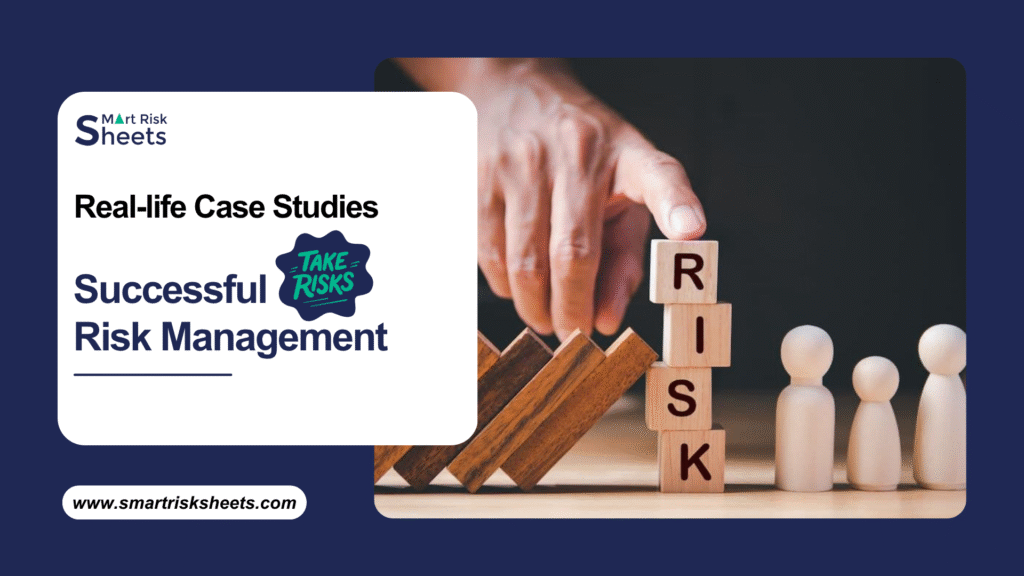
Risk management enables businesses to anticipate potential problems and also create a plan to address the problems if they occur. When there is a thorough plan for risks, projects won’t stop even when surprises pop up because there is a backup plan.
In our computerised age, you’ll agree with me that the business world has changed a lot. For sustainable growth, it is essential for businesses to know how to navigate uncertainty. In this article, we’ve compiled a collection of 6 real-life case studies where Risk Management has made a difference.
Understanding Risk Management

Risk management plays a crucial role in every project. It involves a range of tools to identify potential threats to a project’s success and strategies to mitigate them. For the record, some businesses and companies have failed due to poor risk management. This underscores the need for effective project risk management.
Research shows that businesses that neglect project risk management face a higher chance of failure. Project risk management is a contingency plan that keeps your projects or business process from crashing when the unexpected happens. Understanding and prioritising risk management can save millions in overruns and failed outcomes.
Real Life Case Studies of Effective Risk Management

1. Toyota’s Recall Crisis
Between 2009 and 2010, Toyota had a massive recall of millions of vehicles. This was a result of safety issues related to unintended acceleration. After the massive recall, Toyota improved on its risk management practices and carried out more stringent quality assurance protocols.
The recall affected their reputation and finances. However, Toyota didn’t give up; rather, they utilized the opportunity to strengthen their risk management practices. As a result, they bounced back and recovered quickly, regaining customer trust.
2. Coca-Cola’s Response to Changing Consumer Trends
Coca-Cola is a big name and its risk management practices make it a good fit for this list. Some years back (early 2000s), there was a rise in concerns about obesity and sugary beverages. Coca-Cola took advantage of this situation to diversify its portfolio. Through planning, they were able to identify opportunities as well as potential risks associated with changing consumer preferences.
This identification and analysis led to the introduction of something entirely new—new beverages. They began to make different types of products to cater to various needs. The introduction of low-calorie options and healthier alternatives was a game-changer that allowed Coca-Cola to remain relevant and resilient today.
3. Tesla’s Supply Chain Management
Tesla faced significant supply chain risks, particularly during the semiconductor shortage affecting the automotive industry. To save the situation, the company proactively diversified its suppliers and invested in vertical integration. This approach enabled it to control more of its supply chain.
Tesla also focused on agility, rapidly adapting to changes in component availability. As a result, Tesla was able to maintain production levels and continued to meet demand. This made them outperform many competitors who struggled with supply chain disruptions.
4. J.P. Morgan Chase’s London Whale Incident
In the year 2012, J.P. Morgan Chase experienced trading losses of a whopping $6billion. This was due to unauthorized trades by a trader known as the “London Whale.” The bank had a risk management framework in place, but it failed to identify the scale of the risks associated with the trades.
The bank learned from this incident and strengthened its risk management framework, leading to enhanced risk monitoring and control systems across the organization. They revamped their risk management practices, focusing on better oversight and real-time risk assessment.. This incident ultimately led to tighter regulations in the banking industry.
5. Cybersecurity in Remote Work
2020 was a very interesting year, I must confess. The shift to remote work during the pandemic exposed organizations to increased cybersecurity risks. As a result, companies like Zoom and Microsoft invested heavily in cybersecurity measures, including encryption, multi-factor authentication, and employee training on security best practices.
Furthermore, they also regularly updated their security protocols in response to emerging threats. These proactive measures helped prevent significant breaches and maintain user trust, allowing the platforms to grow rapidly during a time of increased demand for remote communication tools.
6. The Suez Canal Blockage (2021)
The Ever Given container ship blockage in the Suez Canal in March 2021 disrupted global trade significantly. As quickly as they could, companies like Maersk and Hapag-Lloyd implemented immediate risk assessments to reroute vessels and adjust logistics plans. They also communicated transparently with customers about delays and revised shipping schedules. As a result, these companies were able to minimize financial losses and maintain customer relationships by quickly adapting their operations and providing timely information.
Our Verdict on Risk Management
Successful project risk management is crucial for nearly every project. It includes recognizing potential risks and applying strategies to minimize them, helping to secure the project’s success. The Project risk management case studies mentioned above highlight the importance of risk management across various industries, demonstrating its impact on project outcomes.
At SmartRiskSheets, we have seen the benefits of strong project risk management in action. Take advantage of our free, ready-to-use templates designed for SMEs to track, assess, and report risks with ease. Save hours on manual risk scoring with automated dashboards. You can also track risks, severity scores, controls, and residual risk in real time. The best part? You can edit to fit any industry.


Leave a Reply